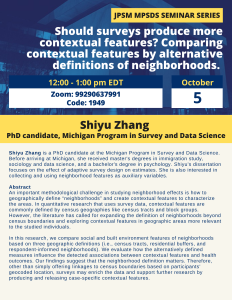Presented By: Michigan Program in Survey and Data Science
MPSDS JPSM Seminar Series - Should surveys produce more contextual features? Comparing contextual features by alternative definitions of neighborhoods
Shiyu Zhang - Michigan Program in Survey and Data Science

MPSDS JPSM Seminar Series
October 5, 2022
12:00 - 1:00 pm
Should surveys produce more contextual features? Comparing contextual features by alternative definitions of neighborhoods.
Shiyu Zhang is a PhD candidate at the Michigan Program in Survey and Data Science. Before arriving at Michigan, she received master's degrees in immigration study, sociology and data science, and a bachelor's degree in psychology. Shiyu's dissertation focuses on the effect of adaptive survey design on estimates. She is also interested in collecting and using neighborhood features as auxiliary variables.
An important methodological challenge in studying neighborhood effects is how to geographically define “neighborhoods” and create contextual features to characterize the areas. In quantitative research that uses survey data, contextual features are commonly defined by census geographies like census tracts and block groups. However, the literature has called for expanding the definition of neighborhoods beyond census boundaries and exploring contextual features in geographic areas more relevant to the studied individuals.
In this research, we compare social and built environment features of neighborhoods based on three geographic definitions (i.e., census tracts, residential buffers, and respondent-informed neighborhoods). We evaluate how the alternatively defined measures influence the detected associations between contextual features and health outcomes. Our findings suggest that the neighborhood definition matters. Therefore, other than simply offering linkages to census boundaries based on participants’ geocoded location, surveys may enrich the data and support further research by producing and releasing case-specific contextual features.
Michigan Program in Survey and Data Science (MPSDS)
The University of Michigan Program in Survey Methodology was established in 2001 seeking to train future generations of survey and data scientists. In 2021, we changed our name to the Michigan Program in Survey and Data Science (MPSDS). Our curriculum is concerned with a broad set of data sources including survey data, but also including social media posts, sensor data, and administrative records, as well as analytic methods for working with these new data sources. And we bring to data science a focus on data quality — which is not at the center of traditional data science. The new name speaks to what we teach and work on at the intersection of social research and data. The program offers doctorate and master of science degrees and a certificate through the University of Michigan. The program's home is the Institute for Social Research, the world's largest academically-based social science research institute.
October 5, 2022
12:00 - 1:00 pm
Should surveys produce more contextual features? Comparing contextual features by alternative definitions of neighborhoods.
Shiyu Zhang is a PhD candidate at the Michigan Program in Survey and Data Science. Before arriving at Michigan, she received master's degrees in immigration study, sociology and data science, and a bachelor's degree in psychology. Shiyu's dissertation focuses on the effect of adaptive survey design on estimates. She is also interested in collecting and using neighborhood features as auxiliary variables.
An important methodological challenge in studying neighborhood effects is how to geographically define “neighborhoods” and create contextual features to characterize the areas. In quantitative research that uses survey data, contextual features are commonly defined by census geographies like census tracts and block groups. However, the literature has called for expanding the definition of neighborhoods beyond census boundaries and exploring contextual features in geographic areas more relevant to the studied individuals.
In this research, we compare social and built environment features of neighborhoods based on three geographic definitions (i.e., census tracts, residential buffers, and respondent-informed neighborhoods). We evaluate how the alternatively defined measures influence the detected associations between contextual features and health outcomes. Our findings suggest that the neighborhood definition matters. Therefore, other than simply offering linkages to census boundaries based on participants’ geocoded location, surveys may enrich the data and support further research by producing and releasing case-specific contextual features.
Michigan Program in Survey and Data Science (MPSDS)
The University of Michigan Program in Survey Methodology was established in 2001 seeking to train future generations of survey and data scientists. In 2021, we changed our name to the Michigan Program in Survey and Data Science (MPSDS). Our curriculum is concerned with a broad set of data sources including survey data, but also including social media posts, sensor data, and administrative records, as well as analytic methods for working with these new data sources. And we bring to data science a focus on data quality — which is not at the center of traditional data science. The new name speaks to what we teach and work on at the intersection of social research and data. The program offers doctorate and master of science degrees and a certificate through the University of Michigan. The program's home is the Institute for Social Research, the world's largest academically-based social science research institute.